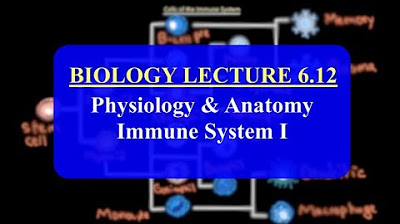Immune Response to Viruses: How the Body Reacts
Summary
TLDRThis video script explains how the immune system combats viral infections, detailing both innate and adaptive immune responses. It covers the structure of viruses, how they invade cells, and the body's first line of defense, including interferons, natural killer cells, and macrophages. The adaptive immune response involves T cells, B cells, and antibodies that target and eliminate viruses. The concept of immunological memory and its role in lasting protection, such as through vaccination, is also discussed. The immune system's intricate mechanisms work together to prevent and fight viral infections effectively.
Takeaways
- 😀 The immune system has multiple mechanisms to combat viral infections, including innate and adaptive responses.
- 😀 A virus needs to invade a living cell to replicate, leading to a viral infection that can cause a variety of symptoms.
- 😀 The virus particle (virion) contains a genome of either DNA or RNA, enclosed in a protein shell called a capsid, and sometimes an additional lipid envelope.
- 😀 The first immune response to a virus is the innate immune system, which includes interferons, natural killer (NK) cells, and antigen-presenting cells.
- 😀 Interferons are signaling proteins that warn neighboring cells to prepare antiviral defenses, preventing virus replication.
- 😀 Natural killer (NK) cells recognize cells with insufficient MHC class I molecules and release toxic substances to destroy infected cells.
- 😀 Macrophages ingest and break down viruses through phagocytosis and also present viral antigens to activate adaptive immunity.
- 😀 The adaptive immune system becomes involved if the innate response cannot curb the infection, involving lymphocytes like T cells and B cells.
- 😀 Cytotoxic T cells (CD8+) kill infected cells by inducing cell death upon recognizing viral antigens on MHC class I molecules.
- 😀 B cells produce specific antibodies that neutralize viruses, mark them for phagocytosis, and activate the complement system to kill infected cells.
- 😀 Immunological memory, formed by memory B and T cells, ensures a quicker response upon re-exposure to the same virus, which is the basis for vaccination.
Q & A
What is the primary function of the immune system in response to viral infections?
-The immune system defends the body against viral infections by detecting and eliminating viruses using both innate and adaptive immune responses.
How do viruses replicate inside the human body?
-Viruses replicate by invading host cells and using the host's cellular machinery to produce viral proteins and genetic material, assembling new virus particles that are released to infect other cells.
What are interferons and what role do they play in the immune response?
-Interferons are signaling proteins released by infected cells to warn nearby cells. They help neighboring cells produce antiviral proteins to prevent viral replication and also enhance immune responses.
How do Natural Killer (NK) cells identify and eliminate infected cells?
-NK cells identify infected cells by detecting the absence of normal MHC class I molecules on the cell surface. They then release toxic substances like granzymes and perforin to kill the infected cell.
What is phagocytosis and which immune cells are involved in this process?
-Phagocytosis is the process by which immune cells like macrophages engulf and digest pathogens such as viruses, breaking them down using digestive enzymes stored in lysosomes.
What is the role of antigen-presenting cells (APCs) in the immune response?
-APCs, such as macrophages and dendritic cells, capture and process antigens from pathogens and present them to other immune cells to trigger a response, linking innate and adaptive immunity.
How do cytotoxic T cells (CD8+ T cells) destroy virus-infected cells?
-Cytotoxic T cells recognize viral antigens on infected cells via MHC class I molecules. They then induce cell death through lysis or apoptosis, effectively eliminating the infected cells.
What is the role of B cells in the immune response to viruses?
-B cells produce antibodies that specifically target viral antigens. These antibodies neutralize viruses, mark them for destruction, activate the complement system, and enhance the killing activity of NK cells.
What is immunological memory and how does it relate to vaccinations?
-Immunological memory is the ability of the immune system to quickly recognize and respond to pathogens it has encountered before. This memory is the basis for vaccinations, which help prepare the immune system for future encounters with specific viruses.
How do antibodies contribute to the immune system’s ability to fight viral infections?
-Antibodies neutralize viruses, enhance their recognition by immune cells for destruction, activate the complement system to damage infected cells, and assist NK cells in targeting infected cells through antibody-dependent cell-mediated cytotoxicity.
Outlines

This section is available to paid users only. Please upgrade to access this part.
Upgrade NowMindmap

This section is available to paid users only. Please upgrade to access this part.
Upgrade NowKeywords

This section is available to paid users only. Please upgrade to access this part.
Upgrade NowHighlights

This section is available to paid users only. Please upgrade to access this part.
Upgrade NowTranscripts

This section is available to paid users only. Please upgrade to access this part.
Upgrade NowBrowse More Related Video

Sistema Imunológico e Imunidade Inata | Anatomia etc

Sistema Imunológico Inato e Adaptativo - Aula 28 - Módulo VII - Histologia e Fisiologia Humana

IMMUNOLOGY- Innate Immunity and Adaptive Immunity (FL-Immuno/01)

IMAT Biology Lesson 6.12 | Anatomy and Physiology | Immune System Part I

B CELLS and T CELLS EXPLAINED!

Lecture 01 : Basic Concepts in Immunology
5.0 / 5 (0 votes)